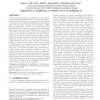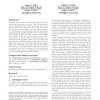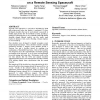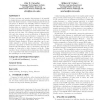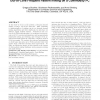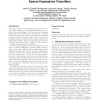KDD
2006
ACM
14 years 12 months ago
2006
ACM
Order-preserving submatrixes (OPSMs) have been accepted as a biologically meaningful subspace cluster model, capturing the general tendency of gene expressions across a subset of ...
KDD
2006
ACM
14 years 12 months ago
2006
ACM
Localized search engines are small-scale systems that index a particular community on the web. They offer several benefits over their large-scale counterparts in that they are rel...
KDD
2006
ACM
14 years 12 months ago
2006
ACM
Typically, data collected by a spacecraft is downlinked to Earth and pre-processed before any analysis is performed. We have developed classifiers that can be used onboard a space...
KDD
2006
ACM
14 years 12 months ago
2006
ACM
To learn concepts over massive data streams, it is essential to design inference and learning methods that operate in real time with limited memory. Online learning methods such a...
KDD
2006
ACM
14 years 12 months ago
2006
ACM
We study the mining of interesting patterns in the presence of numerical attributes. Instead of the usual discretization methods, we propose the use of rank based measures to scor...
KDD
2006
ACM
14 years 12 months ago
2006
ACM
Collaborative recommender systems are highly vulnerable to attack. Attackers can use automated means to inject a large number of biased profiles into such a system, resulting in r...
KDD
2006
ACM
14 years 12 months ago
2006
ACM
In this work we focus on the problem of frequent itemset mining on large, out-of-core data sets. After presenting a characterization of existing out-of-core frequent itemset minin...
KDD
2006
ACM
14 years 12 months ago
2006
ACM
Often the best performing supervised learning models are ensembles of hundreds or thousands of base-level classifiers. Unfortunately, the space required to store this many classif...
KDD
2006
ACM
14 years 12 months ago
2006
ACM
The output of a data mining algorithm is only as good as its inputs, and individuals are often unwilling to provide accurate data about sensitive topics such as medical history an...
KDD
2006
ACM
14 years 12 months ago
2006
ACM
This paper describes a novel classification method for computer aided detection (CAD) that identifies structures of interest from medical images. CAD problems are challenging larg...
